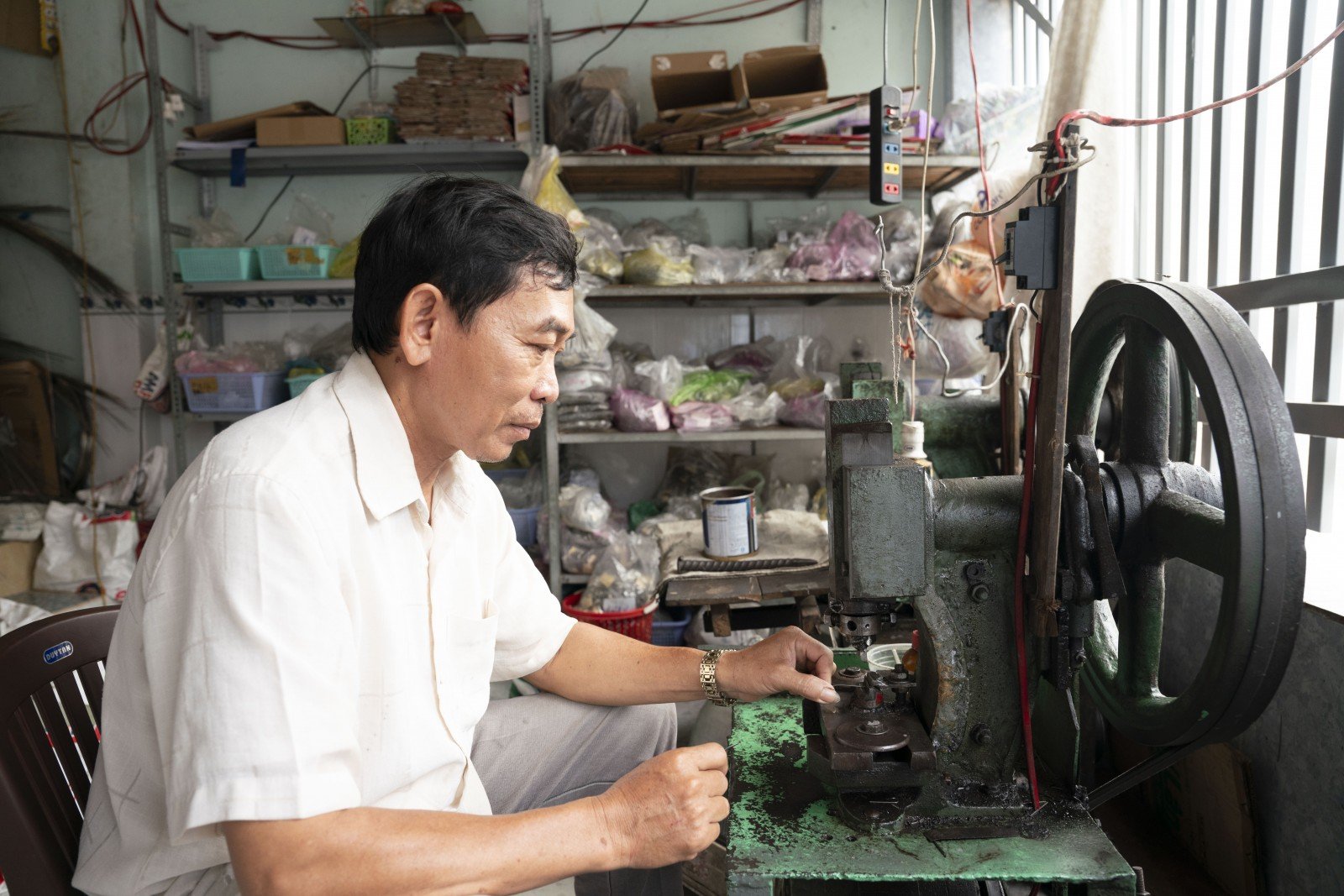Having weathered many ups and downs, the My Hoa fishing hook making village in Tay Khanh 8 hamlet, Long Xuyen ward ( An Giang province) currently has about 10 households specializing in production through a family-to-son tradition. On average, each household employs 3-20 workers and operates throughout the year...
Although its heyday has passed, the craft village still resounds with the sounds of grinding machines, rolling machines, and hammers pressing fishing hooks. During the rainy season, the working atmosphere in the small hamlet becomes even more bustling.

Mr. Nguyen Ngoc Diep sharpens fishing hooks. Photo: TRUNG HIEU
Mr. Nguyen Ngoc Diep, owner of the Ngoc Diep fishing hook production facility, said that My Hoa fishing hooks are famous for their sharpness, high durability, and diverse sizes, so they are in demand year-round. However, the products are most in demand during the flood season, from April to August in the lunar calendar.
His business sells an average of 100,000 hooks (10,000 hooks/hundred) of various types of fishing hooks throughout the Mekong Delta, priced from 500,000 VND to 4 million VND per hundred, depending on size and type.
“My workshop offers about 20 types of fishing hooks in various sizes, including cast hooks, lure hooks, barbed hooks, barbed hooks, shrimp hooks, snake hooks, frog hooks, and even some types of hooks for sea fishing. Depending on customer needs, the workshop will produce hooks to meet their requirements,” Mr. Diep shared.
Having been involved in the craft of making fishing hooks for nearly 50 years, Mr. Nguyen Van Ut shared that this profession is closely linked to the water. Where there is water, there are fish; when there are many fish, the fishing hooks sell well. In recent years, the amount of freshwater fish has decreased sharply, so the traditional craft village is no longer as vibrant as before.
To create a complete fishing hook, the production process involves many steps. Based on the customer's order size, the craftsman straightens the line, cuts it into sections, presses the barbs, cuts the barbs, sharpens the hook, shapes the tip, presses the base, etc., then hardens the hook, polishes it, and finally packages it.
Currently, most of the work is done by machine, but sharpening and adjusting the hook tip must be done manually or semi-manually. "Every step is important, but sharpening the hook is crucial to the product's quality. A hook that 'kills fish' must be sharpened to a uniformly sharp point," Mr. Ut explained.
Similar to the My Hoa fishing hook making village, during the flood season, the people of Can Dang commune's eel trap making village are busy supplying traders and people in the Mekong Delta. Besides making eel traps, they also make shrimp traps, frog traps, snake traps, and snakehead fish traps to diversify the village's products and meet customer demand. Currently, the village still has about 20 households producing these traps, providing regular employment for approximately 100 local workers.
Mr. Nguyen Van Dung Anh, residing in Can Thuan hamlet, said that in recent years, bamboo traps have become increasingly scarce, so people have switched to using plastic pipes or plastic nets. Currently, his facility produces an average of 500-600 traps per day, including bamboo traps, plastic net traps, and PVC pipe traps.
With prices ranging from 25,000 to 27,000 VND per item, after deducting expenses, his family earns a profit of 20 to 30 million VND per month. In addition, the business provides employment for approximately 20 to 30 local workers, with incomes ranging from 2 to 5 million VND per person per month.
According to locals, eel traps are consumed year-round, but the demand is highest during the flood season. Mr. Bui Van Huan, residing in Can Thuan hamlet, said that the eel trap-making profession involves many stages, and each worker is paid differently depending on the step of the job, with an average income of 100,000 - 200,000 VND per day.
“My wife and I work year-round. We make traps for whoever orders them, and even if we don't, we still make them and keep them ready to sell during the flood season. We don't worry about unsold stock. When there's high demand for traps, we focus on weaving them intensively to meet customer orders. Each month, I earn between 3 and 5 million dong from weaving traps. This job doesn't make you rich, but it's enough to cover our living expenses,” Mr. Huan said while weaving traps.
Although these craft villages are no longer as bustling as they were in their heyday, many people still persevere in preserving their trades, viewing them both as a livelihood and a source of pride, the "soul" of their homeland. Each flood season brings with it a new rhythm of life, invigorating the traditional craft villages that quietly and persistently thrive in the fertile Mekong Delta.
LOYALTY
Source: https://baoangiang.com.vn/lang-nghe-song-nho-lu-a464800.html



![[Photo] Prime Minister Pham Minh Chinh receives Lao Minister of Education and Sports Thongsalith Mangnormek](/_next/image?url=https%3A%2F%2Fvphoto.vietnam.vn%2Fthumb%2F1200x675%2Fvietnam%2Fresource%2FIMAGE%2F2025%2F12%2F16%2F1765876834721_dsc-7519-jpg.webp&w=3840&q=75)
![[Photo] Prime Minister Pham Minh Chinh receives the Governor of Tochigi Province (Japan)](/_next/image?url=https%3A%2F%2Fvphoto.vietnam.vn%2Fthumb%2F1200x675%2Fvietnam%2Fresource%2FIMAGE%2F2025%2F12%2F16%2F1765892133176_dsc-8082-6425-jpg.webp&w=3840&q=75)

![[Live] 2025 Community Action Awards Gala](/_next/image?url=https%3A%2F%2Fvphoto.vietnam.vn%2Fthumb%2F1200x675%2Fvietnam%2Fresource%2FIMAGE%2F2025%2F12%2F16%2F1765899631650_ndo_tr_z7334013144784-9f9fe10a6d63584c85aff40f2957c250-jpg.webp&w=3840&q=75)
![[Image] Leaked images ahead of the 2025 Community Action Awards gala.](/_next/image?url=https%3A%2F%2Fvphoto.vietnam.vn%2Fthumb%2F1200x675%2Fvietnam%2Fresource%2FIMAGE%2F2025%2F12%2F16%2F1765882828720_ndo_br_thiet-ke-chua-co-ten-45-png.webp&w=3840&q=75)

































































![[Photo] Prime Minister Pham Minh Chinh attends the Vietnam Economic Forum 2025](https://vphoto.vietnam.vn/thumb/402x226/vietnam/resource/IMAGE/2025/12/16/1765893035503_ndo_br_dsc-8043-jpg.webp)


































Comment (0)